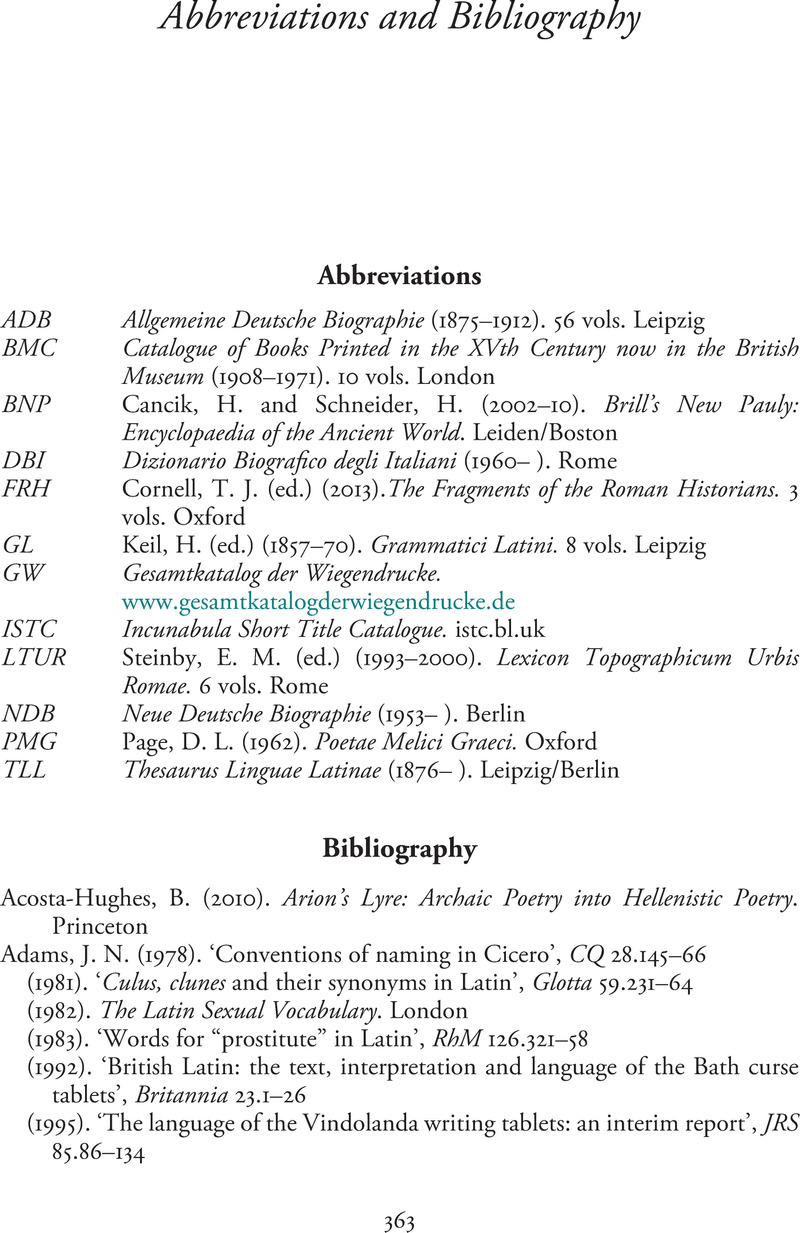Book contents
- The Cambridge Companion to Catullus
- The Cambridge Companion to Catullus
- Copyright page
- Contents
- Notes on Contributors
- Preface
- Introduction
- Chapter 1 Situating Catullus
- Chapter 2 Literary Liaisons
- Chapter 3 Catullan Intertextuality
- Chapter 4 Gender and Sexuality
- Chapter 5 Catullan Themes
- Chapter 6 Language and Style
- Chapter 7 Catullus and Metre
- Chapter 8 Catulli Carmina
- Chapter 9 Catullus and Augustan Poetry
- Chapter 10 Rewriting Catullus in the Flavian Age
- Chapter 11 The Manuscripts and Transmission of the Text
- Chapter 12 Editions and Commentaries
- Chapter 13 Catullus in the Renaissance
- Chapter 14 Catullus and Poetry in English since 1750
- Abbreviations and Bibliography
- Index Locorum
- General Index
- References
Abbreviations and Bibliography
Published online by Cambridge University Press: 09 April 2021
- The Cambridge Companion to Catullus
- The Cambridge Companion to Catullus
- Copyright page
- Contents
- Notes on Contributors
- Preface
- Introduction
- Chapter 1 Situating Catullus
- Chapter 2 Literary Liaisons
- Chapter 3 Catullan Intertextuality
- Chapter 4 Gender and Sexuality
- Chapter 5 Catullan Themes
- Chapter 6 Language and Style
- Chapter 7 Catullus and Metre
- Chapter 8 Catulli Carmina
- Chapter 9 Catullus and Augustan Poetry
- Chapter 10 Rewriting Catullus in the Flavian Age
- Chapter 11 The Manuscripts and Transmission of the Text
- Chapter 12 Editions and Commentaries
- Chapter 13 Catullus in the Renaissance
- Chapter 14 Catullus and Poetry in English since 1750
- Abbreviations and Bibliography
- Index Locorum
- General Index
- References
Summary

- Type
- Chapter
- Information
- The Cambridge Companion to Catullus , pp. 363 - 398Publisher: Cambridge University PressPrint publication year: 2021
References
Abbreviations and Bibliography
Allgemeine Deutsche Biographie (1875–1912). 56 vols. Leipzig
Catalogue of Books Printed in the XVth Century now in the British Museum (1908–1971). 10 vols. London
Cancik, H. and Schneider, H. (2002–10). Brill’s New Pauly: Encyclopaedia of the Ancient World. Leiden/Boston
Dizionario Biografico degli Italiani (1960– ). Rome
Cornell, T. J. (ed.) (2013).The Fragments of the Roman Historians. 3 vols. Oxford
Keil, H. (ed.) (1857–70). Grammatici Latini. 8 vols. Leipzig
Gesamtkatalog der Wiegendrucke. www.gesamtkatalogderwiegendrucke.de
Incunabula Short Title Catalogue. istc.bl.uk
Steinby, E. M. (ed.) (1993–2000). Lexicon Topographicum Urbis Romae. 6 vols. Rome
Neue Deutsche Biographie (1953– ). Berlin
Page, D. L. (1962). Poetae Melici Graeci. Oxford
Thesaurus Linguae Latinae (1876– ). Leipzig/Berlin

